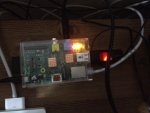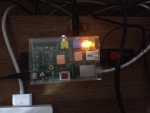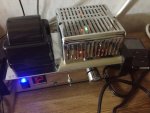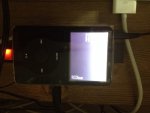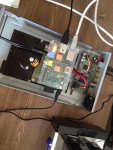- Joined
- Jul 4, 2008
- Messages
- 2,499
- Points
- 113
Alright I think some of you on the forums might like to try building this.
I stumbled upon a open source linux distribution kernel called raspyfi (it's now out of date) and now officially called Volumnio though this is still in a beta phase.
It is built for the Raspberry Pi
512mb revB or higher. The Raspberry Pi is based on a 700Mhz single core ARM 6v with 512Mb of ram and a graphics co-processor. This is a not a very powerful processor but compared to a Arduino Uno it's a rocketship!
Now, let's talk about the project. Raspy-Fi OS allows for real-time streaming of Hi-Fi internet radio stations and onboard decoding of FLAC,ALAC, MP4, MP3 and .wav files at up to 192Khz at 24/32bit. The Raspy-Fi OS has a built in server that allows for remote control of playlists, DAC/ external HD and jog dial control over your LAN or WLAN from any device on your LAN with a web browser including smartphones. It's incredibly flexible in what you can do with it! The sound quality is astounding especially with a USB DAC. :drool:
The build time took a little over an hour to re-format the SDHC class 10 card and do an overclock mod to the Pi and test for stability.
This over clock involves carefully modifying a small document that controls how the memory, card read/write and processor speed behave together. There is a very slight voltage bump to get the core frequency to 1GHz. This over clock improves both the read right latency on the higher end SD cards with write speeds of +40Mb/sec and bumps the graphics and processor responsiveness noticeably. ( I am not going to get into this over clock in this post) but I will explain later on. If you do try doing this mod you do run a risk of corrupting your SD card if it's not a branded card. Branded cards (especially SanDisk) have excellent high-speed memory. The over clocking will force the card memory clock on the card to run out of normal/usual frequency and BRICK cheaper cards. My Sony 8GB SDHC card bricked up almost immediately. The new release of NOOBs V1_3_4 has an over clocker built in but it does not run in RaspyFi.
Alright now the really cool part, since the Raspy-Fi is built around Linux, iPod Classics up to generation 6 running ROXBOX can be used as an external storage device since they to are formatted in NTFS. One can of course also use a 32-64GB USB thumb drive formatted in either NTFS or FAT32 alternatively if needed for using a large HIFI collection.
I have attached several pictures regarding this build and the setup involved.
More pics coming including a new build with an external 500GB HDD with a Sirius Audio based CARAT RUBY DAC as the external sound card and head-amp.
Enjoy.
This has really been an interesting project so far!
:beer::beer::beer::beer:
I stumbled upon a open source linux distribution kernel called raspyfi (it's now out of date) and now officially called Volumnio though this is still in a beta phase.
It is built for the Raspberry Pi
512mb revB or higher. The Raspberry Pi is based on a 700Mhz single core ARM 6v with 512Mb of ram and a graphics co-processor. This is a not a very powerful processor but compared to a Arduino Uno it's a rocketship!
Now, let's talk about the project. Raspy-Fi OS allows for real-time streaming of Hi-Fi internet radio stations and onboard decoding of FLAC,ALAC, MP4, MP3 and .wav files at up to 192Khz at 24/32bit. The Raspy-Fi OS has a built in server that allows for remote control of playlists, DAC/ external HD and jog dial control over your LAN or WLAN from any device on your LAN with a web browser including smartphones. It's incredibly flexible in what you can do with it! The sound quality is astounding especially with a USB DAC. :drool:
The build time took a little over an hour to re-format the SDHC class 10 card and do an overclock mod to the Pi and test for stability.
This over clock involves carefully modifying a small document that controls how the memory, card read/write and processor speed behave together. There is a very slight voltage bump to get the core frequency to 1GHz. This over clock improves both the read right latency on the higher end SD cards with write speeds of +40Mb/sec and bumps the graphics and processor responsiveness noticeably. ( I am not going to get into this over clock in this post) but I will explain later on. If you do try doing this mod you do run a risk of corrupting your SD card if it's not a branded card. Branded cards (especially SanDisk) have excellent high-speed memory. The over clocking will force the card memory clock on the card to run out of normal/usual frequency and BRICK cheaper cards. My Sony 8GB SDHC card bricked up almost immediately. The new release of NOOBs V1_3_4 has an over clocker built in but it does not run in RaspyFi.
Alright now the really cool part, since the Raspy-Fi is built around Linux, iPod Classics up to generation 6 running ROXBOX can be used as an external storage device since they to are formatted in NTFS. One can of course also use a 32-64GB USB thumb drive formatted in either NTFS or FAT32 alternatively if needed for using a large HIFI collection.
I have attached several pictures regarding this build and the setup involved.
More pics coming including a new build with an external 500GB HDD with a Sirius Audio based CARAT RUBY DAC as the external sound card and head-amp.
Enjoy.
This has really been an interesting project so far!
:beer::beer::beer::beer:
Attachments
Last edited:


